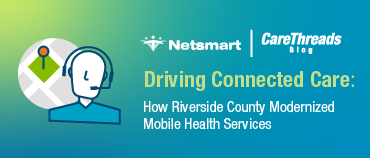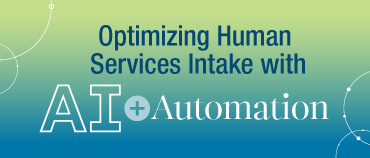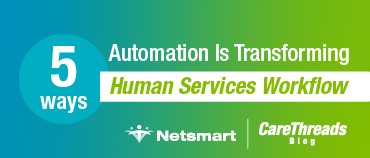It’s not a crisis. It’s a competition.
What do I mean by that? Have you heard people in the industry talking about a “staffing shortage” or an “economic crisis?” These are common challenges. But what if we started using the word “competition” instead of “crisis?” We are living in the most competitive environment I’ve ever seen in human services. That’s a fact. And when I go in competition mode, as opposed to crisis mode, that feels like a much better strategy. I start asking how I can be a disruptor, how I can innovate, and how I can grab market share.
In a recent webinar for OPEN MINDS, I talked about disruption and innovation with two industry leaders. Ashley Sandoval, MBA, SHRM-SCP is the Associate Chief Executive Officer at Emergence, which is a CCBHC and local health authority in El Paso, Texas. Brandon Ward, PsyD, is the Chief Innovation Officer & VP of Information Systems at Jefferson Center, a multi-location behavioral health and addiction agency on the forefront of technology in the Denver area.
Ashley, Brandon and I all agreed that innovation––in particular, technology––is the solution to market challenges we’re facing today. We identified six of those challenges (not necessarily all bad, I should note) for behavioral health organizations:
- Workforce
- The shift to whole-person care
- More choices driving competition
- Renewed focus on behavioral health
- Winning at value-based care
- Overall economic uncertainty
Technology is a savvy strategy for meeting these challenges, because it’s cost-effective, good for employee retention and boosts productivity. But that leads us to another question: where do we focus our efforts? Do we concentrate on sustainability, or keeping the lights on? Or do we lean into agility, or ways to innovate in a challenging market?
Read on to learn what Ashley and Brandon had to say about their own successful efforts.
Run a pilot program
Dr. Brandon Ward oversees technology at Jefferson Center. It’s an organization that embraces agility and innovation culture. But when it comes to introducing new solutions, Brandon says he proceeds with caution.
“There are some things that you just do, like implementing a new EHR. Technology is part of every business. But you have to be careful not to be too disruptive, to the point where it compromises your core. Doing new stuff can be very disruptive to your business lines.”
As a way of managing risk, Jefferson Center adopts a pilot model for new technology that will introduce serious change to the organization. Often bringing a partner into the equation can provide extra support, like when Brandon’s team partnered with Netsmart to implement a remote patient monitoring solution.
“For us, pilots are an important way to not rock the boat too quickly,” Brandon said. “We've seen huge successes in the primary care and physical health world related to remote patient monitoring. But we haven't seen a ton of strong outcomes in research in behavioral health. We just wanted to be a little more careful, right?”
Balancing agility with stability
It's important to note that Jefferson Center is one of the first behavioral health organizations to foray into remote patient monitoring, which accounts for the lack of existing research. But not all pilots are designed for industry-changing projects. Sometimes, it’s a simple matter of adapting to the competitive landscape I’ve been discussing.
“We’re not getting therapists and then psychiatrists coming out of school in droves,” Brandon admitted when discussing workforce challenges. “We had to go back to the drawing board. How do we see more people get better, faster and do it with less skilled folks? That's kind of tricky.
As a result, Jefferson Center built a pilot with a long timeframe to rethink its entire outpatient business––without sacrificing stability in a core service line. Known as Collaborative Care Clinics, these pilot locations organize clinicians into cross-disciplinary teams: therapists, case managers, psychiatrists, nurses, and other types of professionals depending on the population. All locations are walk-in clinics, where consumers can get multiple services in one visit.
By working as a team, Jefferson Center clinicians have been able to compensate for the lack of certain specialists by pooling their collective expertise. The one-stop-shop model has also produced efficiencies for the organization. Collaborative Care Clinics are technology-based, with the option for consumers to download an app and complete all their visits via telehealth, as an alternative to in-person care. An integrated data model pulls together all the information clinicians need, complete with daily team meetings and full visibility into each other’s notes.
Planned disruption
It’s hard to think of a more business-savvy behavioral health organization than Emergence. Believe it or not, the agency was struggling with sustainability when the current leadership took the reins. Since then, Emergence has built nineteen locations, successfully achieved CCBHC status, become the local health authority for the city of El Paso, and cultivated a strong partnership with the El Paso public schools. This kind of growth proves that sustainability and agility go hand-in-hand. So, how did Emergence strategically balance the two?
Ashley is an advocate for disruption, but she says it can’t happen without “taking strategy to paper.” In other words, you need a plan. “We do strategic planning every three years,” Ashley said. “So, we really focus on the national, local and state trends, because obviously those are ever changing.”
Strategic planning is an excellent solution, because you can build in the right amount of sustainability to balance your innovation. For example, how much can you afford to invest in technology? What will you do to get the most from it? Are there partners you can leverage for resources you need?
It’s smart to be bold.
When becoming a CCBHC in 2017, Emergence was able to think creatively, rather than just reacting, because of their emphasis on strategic planning. “We had to begin looking at primary care options,” Ashley recalled. “What we did was hire a Chief Medical Officer, a primary care physician and an addictionologist, because we knew it would really help to have that subject matter expert educating us on primary care services in general––because these are things that we had never done. And today I'm happy to say that we have primary care services at almost all of our 19 locations.”
In other words, Emergence didn’t just hire a primary care doctor. They made an investment in subject matter expertise, which would help them succeed at primary care in the long run. Today, Ashley points to a wide array of services offered by Emergence, including behavioral health, substance use, nutritional therapy, adult primary care and children's services. And they’re continuing to address workforce challenges with an investment mindset. “We just onboarded a neurologist as a Chief Medical Officer as well,” Ashley said. “We saw our psychiatrist doing a lot of referrals to neurology. And so that's also going to be very, very new for us.” It’s also going to bring these referrals in house, resulting in more sustainability for Emergence.
The right equation
Both Brandon and Ashley have found ways of balancing sustainability and agility to grow their organizations. For Brandon and Jefferson Center, it’s a focus on technology with pilot programs to “test the waters” before rolling out any significant changes to core service lines. For Ashley and Emergence, it’s strategic planning which encourages an innovation mindset but always asks the question, “is this a good financial investment?” It’s easy to see why both organizations are leading the way in human services.
Let’s take another look at the six challenges I mentioned at the beginning of this article and briefly discuss with Brandon and Ashley how to address these issues directly.
Workforce
“In Colorado, our clinicians spend a lot of time doing things like filling out documents that go to the state. It really drives our exit interviews. It’s very common to hear ‘If I didn't have to do so much darn paperwork…’” Brandon said. Jefferson Center isn’t alone. Clinicians across the country handle large caseloads and spend about 40% of their time on documentation. But Brandon and his team have implemented an AI/natural language processing (NLP) technology that can cut documentation time in half, while improving the quality of notes. “We’re reducing the ––I’ll call it ‘brain damage’––that occurs when you have to write note after note after note after note all day long,” he says.
These AI tools can:
- Suggest billable language
- Generate CPT codes
- Eliminate human errors
- Increase staff satisfaction by freeing clinicians up to provide care
Whole-person care
Ashley admitted that CCBHC status only required Emergence to offer “primary care screening.” But that’s not much of an investment, so her team added medical specialists to help them run the program. Simply adding more service lines isn’t strategic growth. Here are some ways you can ensure your technology is designed to optimize resources for whole-person care:
- Does it allow you to share data with anyone in your organization, from primary care doctors to DSPs?
- Can medication lists be shared and prescriptions uploaded for online order?
- If you offer autism care, is therapy such as ABA by Rethink integrated into your EHR?
- Are workflows and forms customizable for new providers like nutritionists or nurses?
More choices driving competition
By definition, standing out from the competition means innovating and offering something unique. According to Ashley, it also means partnership. “In the past three years we've gotten ourselves into the schools, providing onsite services coupled with crisis intervention teams with the school officers,” she explained. Because of this relationship with the public schools, people in El Paso think of Emergence as part of the community.
Of course, Ashley cautions that programs like these can be hard to fund. But Emergence has never been shy about partnering with organizations who can help. Netsmart actually provides operational and strategic support to Emergence––not just IT. Community partnership means more resources for Emergence as well.
Value-based care
No matter where you are in your CCBHC journey, the most important strategy is to be data-ready. As Brandon noted: “Colorado is not there yet with CCBHC. It’s all about setting a framework for how we how we show the value to all of our payers.”
To accomplish this, Jefferson Center is piloting a data-integrated exchange, a “shared data warehouse” where information can simply flow in from the EHR. To meet the future of value-based care, your EHR must have advanced data collection and reporting functions, such as:
- Access to an automated data repository (CCBHCs can often use a statewide database)
- Robust analytics to generate custom reports for funding and compliance
- Information that’s readily available to your clinical staff for decision-making and evaluation
Economic uncertainty
I want to repeat what I said before. It’s not a tough economy––it’s a competitive one. Whether you’re a nonprofit or public agency, you need to generate revenue. That’s nothing new. But with the right combination of sustainability and innovation, you can actually grow and scale. Ashley, Brandon and I all agree that technology is your first line of defense if you want to drive efficiency, increase staff retention, add service lines, win grants, increase visits and get paid for improving care outcomes.
This is actually a time of tremendous optimism for behavioral health. You simply need the right tools, and the right partners on your side. Netsmart is here to provide you with both.
About the Author
Neal Tilghman, Senior Director & GM, Integrated Care
As General Manager of Integrated Care, Neal Tilghman endorses a client focused and strategic market model around Netsmart’s solutions with a keen awareness of the current state of behavioral health, addictions treatment and physical health, while maintaining a forward-looking approach as to where our clients need to be and how we get them there with the appropriate technology. Neal completed his graduated studies at East Carolina University and has 30 years of experience in behavioral health.








